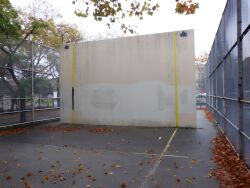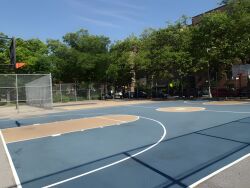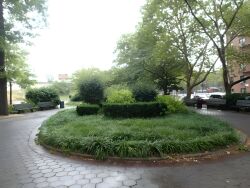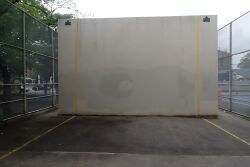Barrier Playground
Handball Haven
On August 30, 1854, the City of New York acquired this property, and the land that would become Horace Harding Expressway, through condemnation. The City placed the property under NYC Parks jurisdiction on the same day. Originally named Hard Courts Area, the park is now known as Barrier Playground, or more affectionately as “Handball Haven.”
Handball is one of the most popular games in the city and has long been identified with New York; however, the game can be traced back through history to depictions in Egyptian tombs dating to 2000 BC, and in Native American sites in Arizona and Nicaragua circa 1500 BC. Homer himself described the game in his epic poem, The Odyssey, as an invention of Princess Anagalla of Sparta.
From its ancient origins, the modern-American incarnation of handball has evolved through time. In the late-19th century Irish immigrants brought a 1,000-year old Irish adaptation of the game, known as “hard handball,” to New York City. It quickly caught on with the public, and in 1948 NYC Parks started sponsoring citywide handball tournaments, with the first at Heckscher Playground on 63rd Street and West Drive in Central Park.
Modern handball may be played on one-wall, three-wall, or four-wall courts; the one wall version is the most popular. The court consists of a wall, twenty feet wide and sixteen feet high. Drawn sixteen feet away and parallel to the front wall is the “short line,” which separates the front-court from the back-court, with service markers located nine feet behind the short line. The area between these two lines is the service zone.
Players use a hollow, rubber or synthetic-rubber ball that weighs 2.3 ounces and is 1.88 inches in diameter. The server puts the ball in play from the service zone by letting it bounce and then striking it into play. The purpose of the game is to hit the ball against the wall without letting the receiving player return the ball; when serving, the ball must bounce past the short line. The receiver must return the ball against the wall before it bounces twice. A point is awarded to the server if this is not accomplished. Alternately, once a volley is in progress, the server can lose the service if he/she cannot return the ball. Games are played to twenty-one points, with the winner of the best of three games taking the match. In 1951 the U.S. Handball Association (USHA) was formed in order to standardize the rules and promote the game.
In January 2000, NYC Parks announced an initiative to renovate the 1,500 of the 2,052 handball courts across New York City’s parks and playgrounds. Improvement efforts included graffiti removal, repainting, maintenance of court surfaces, and repair of the wall expansion joints. In celebration of the initiative, NYC Parks hosted the City’s first amateur handball tournament, which occurred in locations throughout all five boroughs in June 2000.
Today, Barrier Playground hosts basketball courts, a sitting area, and two handball courts for those who enjoy the game that has captivated players over the past thousand years.
Check out your park's Vital Signs
Clean & Safe
Green & Resilient
Empowered & Engaged Users
Share your feedback or learn more about how this park is part of a
Vital Park System





